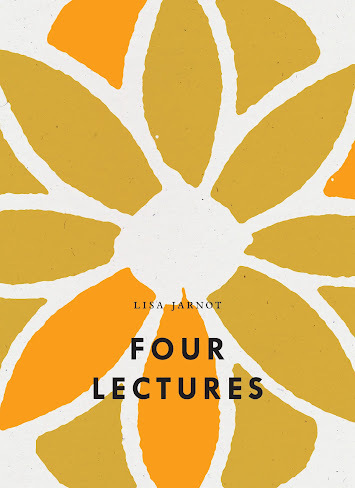Lisa Jarnot, FOUR LECTURES
What I had intuited about the possibilities of the poemwere confirmed by [Robert] Duncan and his circles (both at Black Mountain andin San Francisco): that a poem was obviously not a static commodity, it was anorganic system living in time and space.
 Anynew title by Jackson Heights, Queens poet Lisa Jarnot is equally exciting to anew title in The Bagley Wright Lecture Series produced through Wave Books, and Jarnot’sFOUR LECTURES (Wave Books, 2024) manages to provide both simultaneously.“I seem to have the mind of a poet,” she writes, near the opening of the firstlecture, “which makes me good at poaching and weaving, and not so inclined totraditionally academic discourse.” There is something delightfully anddeceptively uncomplicated about Jarnot’s language across these four lectures,set into a cadence of intimate complexity. If you aren’t aware, I’m a big fanof The Bagley Wright Lecture Series as produced through Wave Books, although attimes I’m often too busy responding to and through such generative texts via myown writing to be able to properly respond to the books themselves through thespace of a review, although I have managed to post reviews of Rachel Zucker’s ThePoetics of Wrongness (2023) [see my review of such here] and DorothyLasky’s Animal (2019) [see my review of such here], as well as mentionJoshua Beckman’s Three Talks (2018) via the substack a while back.
Anynew title by Jackson Heights, Queens poet Lisa Jarnot is equally exciting to anew title in The Bagley Wright Lecture Series produced through Wave Books, and Jarnot’sFOUR LECTURES (Wave Books, 2024) manages to provide both simultaneously.“I seem to have the mind of a poet,” she writes, near the opening of the firstlecture, “which makes me good at poaching and weaving, and not so inclined totraditionally academic discourse.” There is something delightfully anddeceptively uncomplicated about Jarnot’s language across these four lectures,set into a cadence of intimate complexity. If you aren’t aware, I’m a big fanof The Bagley Wright Lecture Series as produced through Wave Books, although attimes I’m often too busy responding to and through such generative texts via myown writing to be able to properly respond to the books themselves through thespace of a review, although I have managed to post reviews of Rachel Zucker’s ThePoetics of Wrongness (2023) [see my review of such here] and DorothyLasky’s Animal (2019) [see my review of such here], as well as mentionJoshua Beckman’s Three Talks (2018) via the substack a while back.Jarnotis the author of a small mound of poetry titles, including Some Other Kingof Mission (Providence RI: Burning Deck, 1996), Ring of Fire (ZolandBooks, 2001; Salt Publishers, 2003), Black Dog Songs (Chicago Il: FloodEditions, 2003), Night Scenes (Flood Editions, 2008), Joie De Vivre:Selected Poems 1992-2012 (San Francisco CA: City Lights, 2013) [see my review of such here] and A Princess Magic Presto Spell (Flood Editions,2019) [see my review of such here], as well as Robert Duncan, The Ambassadorfrom Venus: A Biography (Berkeley CA: University of California Press,2012). These four lectures offer an insight, across a wide critical landscape,of how Jarnot the poet got to where she is now, writing on grad school, beatpoets, errant youth, interacting with Robert Creeley and the incredible fact ofher being able to catalogue Robert Duncan’s papers and archive, and learningthe depth and the breadth of his work through that particular process. If youare a reader of Duncan, or even if you aren’t, the tale she tells of helping saveand salvage the legendary scattered manuscript of what was later published as RobertDuncan’s The H.D. Book (University of California Press, 2011), edited byMichael Boughn and Victor Coleman, is absolutely wild. “The H.D. Bookbecame the single most important influence on my understanding of a poetics.And not a single page of it disappointed.” she writes, as part of the secondlecture. Jarnot’s lectures provide insight to how she developed an approach tounderstanding and acknowledgings the traditions but also working to breakthrough to what might follow, as she writes early in the second lecture,“ABANDON THE CREEPING MEATBALL,” an essay subtitled “An Anarcho-SpiritualTreatise”:
The first room is notjust a room but also a book. The room is in a house on the north side ofBuffalo in the late 1980s. The book is The H.D. Book by Robert Duncan.The house, at 67 Englewood Avenue, housed an anarchist collective, or at leastwe, the inhabitants, imagined ourselves that way. There were usually about tenof us living in that house at a time, in our late teens and early twenties, mostlystudents. I’ve been trying to remember what drew us all together there. Ourscene was a little bit queer, it was very much to the left of center, and Ithink we were mostly coming from tight places, economically, within ourfamilies of origin. We were mostly of the first generation in our families togo to college. Two instincts were very alive in that moment, in that house:first, a fierce resistance to the culture around us; to the educationalculture, to the social expectations, to the state, to religion. And we dididentify as anarchist with a capital A: we were very clear that anarchynever meant “helter-skelter” chaos, but that it meant listening for moreorganic alternatives to the inscribed laws around us. We were looking fornatural orders of community. And that resistance to the culture made room for alot of revelation about potential alternatives.



